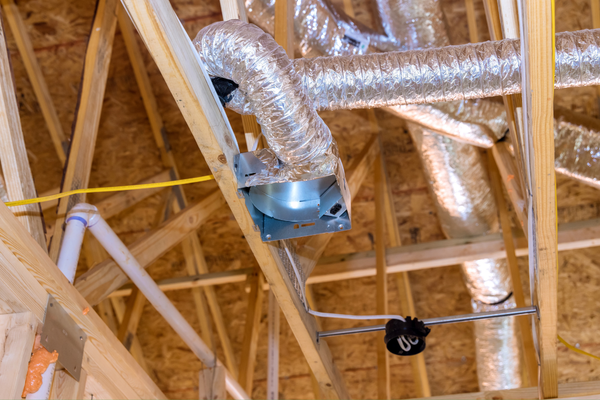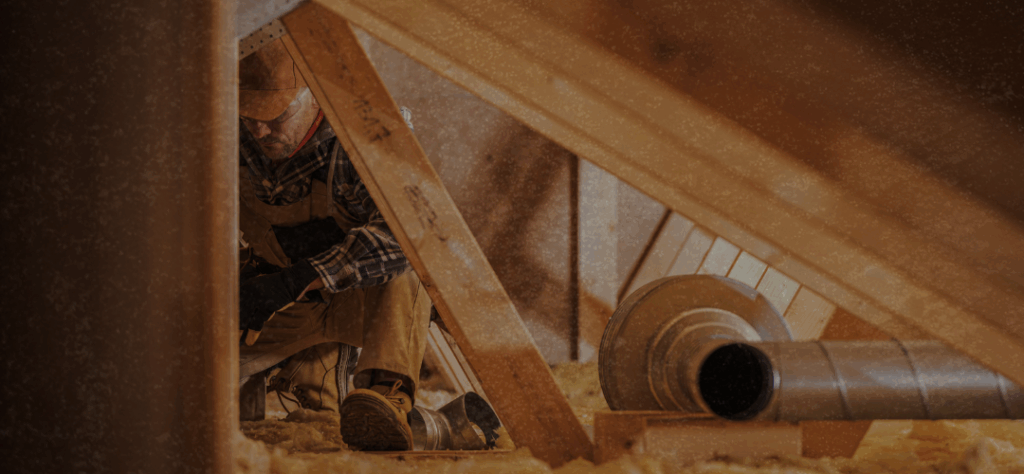Is Your Attic Working Against You?
You have set the thermostat to 74 degrees, but the upstairs still feels like a sauna. You find yourself paying more to FPL each year, but your comfort is going down. The problem is not your air conditioner—it is an inefficient attic. Many people do not realize that their attic is the control center for their home’s energy use. In Jupiter’s warm and humid climate, an attic that is not managed well actively works against your comfort and your budget. It can trap heat, let in moisture, and make your AC unit run constantly just to keep up. This puts a strain on your equipment and your wallet.
The good news is that there is a powerful solution. It is a two-part system that creates total attic efficiency. This system involves complete air sealing and balanced ventilation. When these two parts work together, they turn your attic from a problem area into a source of savings and comfort. This approach stops the leaks that waste money and allows your home to breathe correctly, removing superheated air and moisture.
What is inside this guide? We will look at common myths about attics in Florida. We will explore the details of the two-part system that brings true efficiency. You will also learn about the real return on investment for a Jupiter homeowner, looking at savings, comfort, and safety. Finally, we will help you decide between doing it yourself and calling a professional. This guide will give you the knowledge you need to take control of your home’s performance. The team at All Thermo Insulation is here to help you understand your home’s needs.
Table of Contents

Attic Myths vs. Facts: Jupiter Climate Edition
There is a lot of bad information out there about how attics work, especially in a unique climate like ours in Jupiter. Let’s clear up some of the most common myths with facts.
Myth #1: My Home is New, so it doesn’t have Air Leaks.
Fact: This is one of the biggest mistakes new homeowners make. A new house does not mean an airtight house. During construction, workers cut dozens of holes in your home’s structure. Holes are made for plumbing pipes, electrical wires, recessed lights, and bathroom fans. Each one of these small openings becomes a path for air to travel. A single small gap might not seem like a big deal. But when you add them all up, it is like leaving a window wide open all year long. Air from your cool living space rushes up into the hot attic, and hot, humid attic air can be pulled down into your home. This process, known as the “stack effect,” makes your air conditioner work much harder to maintain the temperature you want. Finding every one of these gaps is key to real home efficiency.
Myth #2: Insulation is the Only Thing that Matters in an Attic.
Fact: Thinking that insulation alone will solve your attic problems is like wearing a winter coat with the zipper wide open on a windy day. The coat is made of warm material, but the wind still gets through and makes you cold. Insulation works by trapping pockets of air to slow the movement of heat. If air can move freely through and around your insulation, its power is greatly reduced. Air sealing is the process of finding and filling all the gaps first. This creates an air barrier. Once the barrier is in place, your insulation can do its job the way it was meant to. For homeowners in Jupiter, sealing must always come before adding more insulation. Otherwise, you are just putting a blanket over a leaky structure, and you will not get the comfort or savings you expect. Getting your insulation services done right means sealing first.
Myth #3: It’s Normal for a Florida Attic to be Extremely Hot.
Fact: Your attic will always be the warmest part of your house, but temperatures that reach 150°F or more are not normal. Extreme heat is a clear sign that your attic cannot get rid of the hot air that builds up. This is a big problem with your attic ventilation. When the sun beats down on your roof, it heats the air inside the attic. Without a path to escape, this superheated air gets trapped. It radiates down into your living space, heating up your ceilings and making your AC run nonstop. This trapped heat can also damage the shingles on your roof from the inside out, shortening their life. The goal of proper attic ventilation is to move that superheated air out and replace it with cooler air from outside. A well-ventilated attic will stay much closer to the outside air temperature, protecting your roof and giving your air conditioner a much-needed break.
The Two-Part System for a Perfect Jupiter Attic
The best way to fix an inefficient attic is to think of it as a single system with two vital parts. You need to both seal the attic off from your living space and make sure it can breathe to the outside. Doing just one without the other will not give you the results you want. An experienced attic ventilation contractor knows how to balance these two parts perfectly.
Part 1: Creating the Seal – Stopping Uncontrolled Airflow
The first goal is to build a complete air barrier between your home and your attic. Think of it like a submarine. You would not want any leaks letting water in. In your home, you do not want any leaks letting your expensive cool air out or letting hot, dirty attic air in.
The “why” is simple. You want to stop air from moving where you do not want it to. Every bit of conditioned air that escapes into the attic is money wasted. Every bit of hot, humid, or dusty air that gets pulled into your home affects your comfort and your family’s health. By creating a solid seal, you take charge of your home’s air.
The “how” involves using special materials to close every gap. Professionals use things like fire-retardant expanding foam, strong caulk, and solid foam boards. The work focuses on key weak spots where leaks are most common. These include the tops of interior walls, called “top plates.” They also include any place a wire or pipe goes through the ceiling. Soffits, recessed lights, and the attic access hatch are other big problem areas. A professional with experience knows where to look for these hidden leaks that most homeowners would never find.
Part 2: Allowing the Breath – Mastering Controlled Airflow
Once you have stopped air from moving between your house and the attic, you need to make sure air can move correctly within the attic itself. This is the ventilation part of the system. This controlled airflow is very different from the uncontrolled airflow of leaks.
The “why” here is all about removing two big enemies of a Florida home: heat and moisture. As the sun heats your roof, that heat needs a way to escape. Proper ventilation creates a path for it to leave. At the same time, moisture can build up in an attic from daily activities like showering and cooking. If this moisture gets trapped, it can lead to wood rot and mold growth. A breathing attic is a dry and healthy attic.
The “how” is about creating a balanced system. The system needs a place for air to come in and a place for it to go out. Intake vents, usually in the soffits (the underside of your roof’s overhang), let cooler outside air enter the attic. Exhaust vents, which can be ridge vents at the peak of the roof or gable vents on the sides, let the hot air out. This creates a natural flow as hot air rises and escapes, pulling in cooler air behind it. This process of natural convection keeps the attic from overheating. A professional company like All Thermo Insulation knows how to calculate the exact amount of ventilation your specific attic needs to work correctly.

What’s the Real ROI? A Jupiter Homeowner’s Perspective
Making an improvement to your home is an investment. You want to know what you are getting back in return. For attic efficiency, the return on your investment, or ROI, comes in three important ways: money, comfort, and safety.
The Financial ROI
The most direct return is on your monthly FPL bill. When you stop conditioned air from leaking out and prevent extreme attic heat from getting in, your air conditioner does not have to run as much. It can reach your desired temperature more quickly and stay off for longer periods. This reduced runtime can lead to noticeable savings every single month, especially during the long, hot summers in Jupiter.
But the savings do not stop there. Think about the long-term picture. Your HVAC system is one of the most expensive pieces of equipment in your home. An inefficient attic puts a huge strain on it, forcing it to work overtime day after day. This extra wear and tear can lead to more frequent breakdowns and a shorter lifespan for the entire unit. By improving your attic, you are protecting your HVAC investment and delaying the very high cost of a full replacement. All Thermo Insulation has seen this direct link between attic work and HVAC health for over 20 years.
The Comfort ROI
You cannot put a price on feeling comfortable in your own home. Do you have rooms that are always hotter than others? Is your second floor always a few degrees warmer than your first? These are classic signs of an attic problem. When you seal and ventilate your attic correctly, you will feel the difference.
Temperatures become more consistent from room to room and floor to floor. The hot spots disappear. Your home just feels more pleasant. Another big comfort factor is humidity. A leaky attic can pull in a lot of Jupiter’s humid outdoor air. This makes your home feel sticky and damp, even when the AC is running. A well-sealed attic reduces this problem, making your home feel cooler and drier. It is a change you can truly feel. This also helps your AC ductwork services perform better by not having to fight extra humidity.
The Health & Safety ROI
What is in your attic air? Often, it is a mix of dust, loose insulation particles, and even mold spores if you have a moisture problem. When your house has air leaks, it can pull that contaminated air down into the rooms where your family lives and breathes. Sealing the attic helps stop this.
Improving your home’s air quality is a major benefit. It is especially important for family members with allergies or asthma. A clean and well-maintained system, which includes regular air duct cleaning service, is part of a healthy home environment. Sealing the attic is a foundational step.
There is also a safety benefit related to Florida’s weather. During a hurricane, major pressure differences can build up between the inside and outside of a house. These pressure changes can put a lifting force on your roof. A well-sealed attic and roof deck can reduce these pressure changes. This can make your roof more resilient during a storm, giving you greater peace of mind.
DIY vs. Pro: Making the Right Call for Your Attic
Should I Try to Do This Work Myself?
Some homeowners who are good with tools might wonder if they can handle attic work on their own. There are a few small tasks that a handy person could potentially tackle.
You could check the weatherstripping on your attic access hatch or door. This is a common spot for leaks and is easy to fix. You could also do a visual inspection. On a cool day, you could carefully look around for any obvious large holes or gaps, especially around plumbing pipes that you can easily see and reach.
When to Call a Professional
The truth is that most of the important work in an attic should be left to trained professionals. The environment can be difficult and dangerous, and the work requires special knowledge. Here are clear signs that you need to call an expert like All Thermo Insulation.
If you have recessed “can” lights in your ceiling, these are a major source of air leaks. They also get very hot. You cannot just spray foam around them. They require special, fire-rated covers to be sealed safely. Trying to do this yourself is a serious fire hazard.
If you see any signs of mold, dark stains on the wood, or feel dampness, you need a pro. This suggests a moisture problem that needs to be solved before any sealing is done. Covering up a moisture issue will only make it worse.
Attics are often tight, difficult spaces to move around in. You have to be careful not to step through the ceiling drywall. There is also complex wiring and ductwork to navigate. Professionals have the right safety gear and training to work in these conditions. To get a truly complete seal, you need professional equipment like a blower door. This machine helps pinpoint exactly where all the hidden leaks are. Without this tool, you are just guessing. A company like All Thermo Insulation offers a full home energy audit to find every problem.
Take Control of Your Home’s Performance
Your attic is the key to a more comfortable, affordable, and resilient home in Jupiter. It is not just a space for storage. It is the heart of your home’s performance. Ignoring it means paying too much for energy, living with uncomfortable hot spots, and letting your expensive HVAC system wear out too fast.
The most effective way to fix these problems is with a combined strategy. Professional air sealing stops the energy waste. Proper attic ventilation gets rid of damaging heat and moisture. Together, they create a home that works better in every way. You can make your home a true haven from the Florida heat.
Ready to uncover your attic’s potential? Contact All Thermo Insulation for a complete home energy audit and attic assessment in Jupiter! Our team of experts will show you exactly what your home needs to be at its best.

